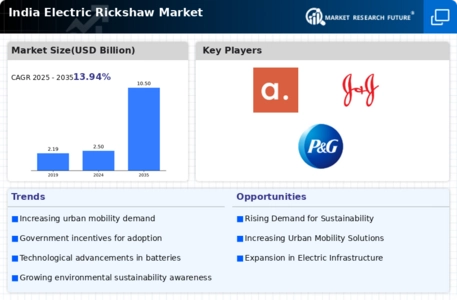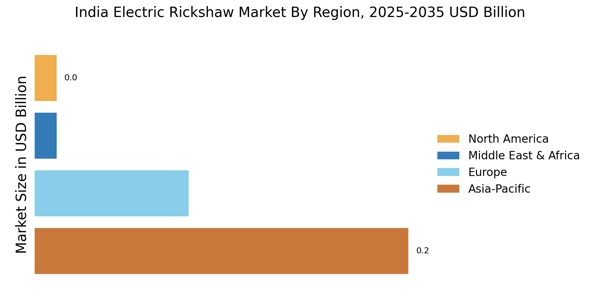Cost-Effectiveness
The cost-effectiveness of electric rickshaws is a compelling driver for the India Electric Rickshaw Market. Compared to traditional fuel-powered vehicles, electric rickshaws offer lower operational costs due to reduced fuel expenses and maintenance requirements. The price of electricity is generally lower than that of petrol or diesel, making electric rickshaws a more economical choice for drivers and fleet operators. Additionally, the long-term savings associated with electric vehicles, including government incentives, further enhance their appeal. As the cost of electric rickshaw ownership decreases, more individuals are likely to invest in this mode of transport, thereby contributing to the market's growth.
Rising Urbanization
The rapid urbanization in India is a pivotal driver for the India Electric Rickshaw Market. As cities expand, the demand for efficient and eco-friendly transportation solutions increases. Urban areas are experiencing a surge in population density, leading to traffic congestion and pollution. Electric rickshaws offer a viable alternative to traditional vehicles, providing last-mile connectivity in densely populated regions. According to recent estimates, urban areas in India are expected to account for over 50% of the total population by 2030, further propelling the need for sustainable transport options. This trend indicates a growing acceptance of electric rickshaws as a preferred mode of transport, thereby enhancing the market's growth potential.
Environmental Concerns
Growing environmental awareness among consumers is a significant driver for the India Electric Rickshaw Market. With increasing concerns about air quality and climate change, there is a shift towards sustainable transportation solutions. Electric rickshaws produce zero tailpipe emissions, making them an attractive option for environmentally conscious consumers. The Indian government has also recognized the need to reduce pollution levels in urban areas, leading to stricter regulations on conventional vehicles. This heightened focus on sustainability is likely to encourage more individuals and businesses to adopt electric rickshaws, thereby fostering market growth. The alignment of consumer preferences with environmental goals presents a unique opportunity for the industry.
Technological Innovations
Technological advancements are significantly influencing the India Electric Rickshaw Market. Innovations in battery technology, such as lithium-ion batteries, have improved the efficiency and range of electric rickshaws. Enhanced charging infrastructure is also being developed, making it easier for operators to maintain their vehicles. The integration of smart technologies, such as GPS and telematics, is further optimizing fleet management and operational efficiency. As these technologies evolve, they are expected to reduce operational costs and improve the overall user experience, thereby attracting more consumers to electric rickshaws. This trend suggests a promising future for the market as technology continues to advance.
Government Support and Policies
Government initiatives play a crucial role in shaping the India Electric Rickshaw Market. The Indian government has introduced various policies aimed at promoting electric vehicles, including subsidies and incentives for manufacturers and consumers. The Faster Adoption and Manufacturing of Electric Vehicles (FAME) scheme is one such initiative that encourages the adoption of electric rickshaws by providing financial support. Additionally, state governments are implementing their own policies to facilitate the growth of electric mobility. These supportive measures are likely to enhance the market landscape, making electric rickshaws more accessible and affordable for consumers, thus driving market expansion.


















Leave a Comment